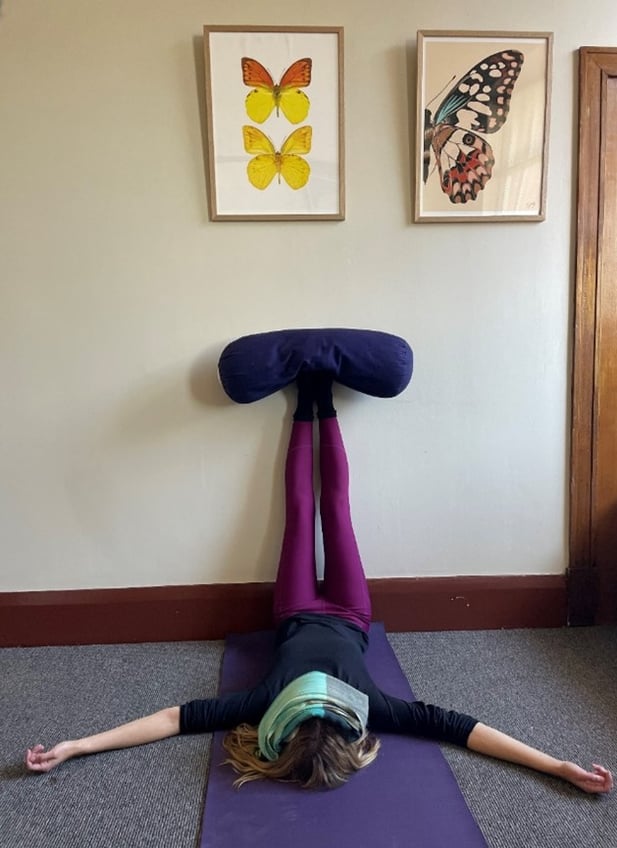Yoga has been used for thousands of years as a tool to promote physical, spiritual, and emotional wellbeing. Studies suggest there is benefit in adding yoga practices alongside mental health treatment especially for depression, anxiety and trauma (Van der Kolk, West, et al., 2014; Brinsley, Schuch, et al., 2021).
Here are three simple yoga poses that can be safely and easily accessed by most people to create a felt sense of grounding and ease within everyday life, with minimal time or resources.
Supported child’s pose (balasana)
The Supported Child’s Pose is grounding and calming whilst providing a gentle stretch in your lower back and hips. This is a great pose for self-soothing and quieting the mind and body before bed or any time you need to feel calm during the day. If it feels comfortable, close your eyes and bring attention to your breath, lengthening the exhalation.

How to get into the pose: Place a bolster (or pillow, long cushion) between your knees, and from a wide-kneeling position, slowly lower your chest and belly along the bolster. Slide the end of the bolster to be snug between your knees. Your knees are wider than your hips. Rest your cheek to one side and allow your arms to drape alongside you. If your hips are uncomfortable place a small, folded blanket between the backs of the thighs and the calves, you can also add another bolster or cushion until the height is comfortable. You may also like to add a blanket over you for added warmth. Stay for a few minutes and make sure to turn your head to the other side halfway through.
Legs up the wall pose (viparita kirani)
Legs up the wall is wonderful restorative pose if you are experiencing stress or anxiety and is also beneficial for circulation. This pose can be done anywhere and by most people. It’s especially good for people who sit for long hours, like computer based workers.

How to get into the pose: Begin seated with one hip close to the wall, then lying down on your side roll onto your back and extend your legs up the wall, the back of your legs flat against the wall. Your feet are relaxed, it may feel nice to place a cushion on your feet. Feel free to shuffle your body close to the wall. Allow your arms to rest by your side, soften your neck and jaw. If it feels comfortable, cover your eyes with a small scarf or an eye pillow. Stay here for as long as you wish.
Reclined butterfly pose (supta baddha konsana)
Reclined butterfly pose is a great passive stretch for the hips, spine, and shoulders. This one is excellent for people who spend a lot of time hunched over a computer as it opens the shoulder cavity. Great for stress and shoulder tension, anxiety, and generally calming.

How to get into the pose: Grab several blankets, cushions, towels or bolsters whatever you have available. If you don’t have a bolster and blocks like the picture below, you can use a couple rolled towels on an incline over some old phone books. Recline over the base of the bolster, allowing the spine to rest along the bolster and your hands drape either side. Your chest and shoulders should feel open and at ease. With the soles of the feet together allow the knees to open comfortably wide, prop some bolsters or blankets under each knee, taking the time to make yourself as comfortable as possible so the knees can be fully relaxed. You may like to place an eye pillow or scarf over the eyes. Stay here as long as you need.
References Brinsley, J., Schuch, F., Lederman, O., Girard, D., Smout, M., Immink, M. A., Stubbs, B., Firth, J., Davison, K., Rosenbaum, S. (2021). Effects of yoga on depressive symptoms in people with mental disorders: a systematic review and meta-analysis. British journal of sports medicine, 55(17), 992–1000. Van der Kolk, B., West, L., Rhodes, A., Emerson, D., Suvak, M., Spinazzola, J. (2021) Yoga as an adjunctive treatment for PTSD: A randomized controlled trial. The Journal of Clinical Psychiatry, 75(6), 22573.
.png)
About The Author
Dr Ted Cassidy
Dr. Ted Cassidy is a psychiatrist and co-founder of Monarch Mental Health Group in Australia, which provides innovative treatments for depression, PTSD, and anxiety. Monarch Mental Health is recognized as Australia's first outpatient clinic offering assisted therapy and is the largest provider of outpatient magnetic stimulation therapy.

